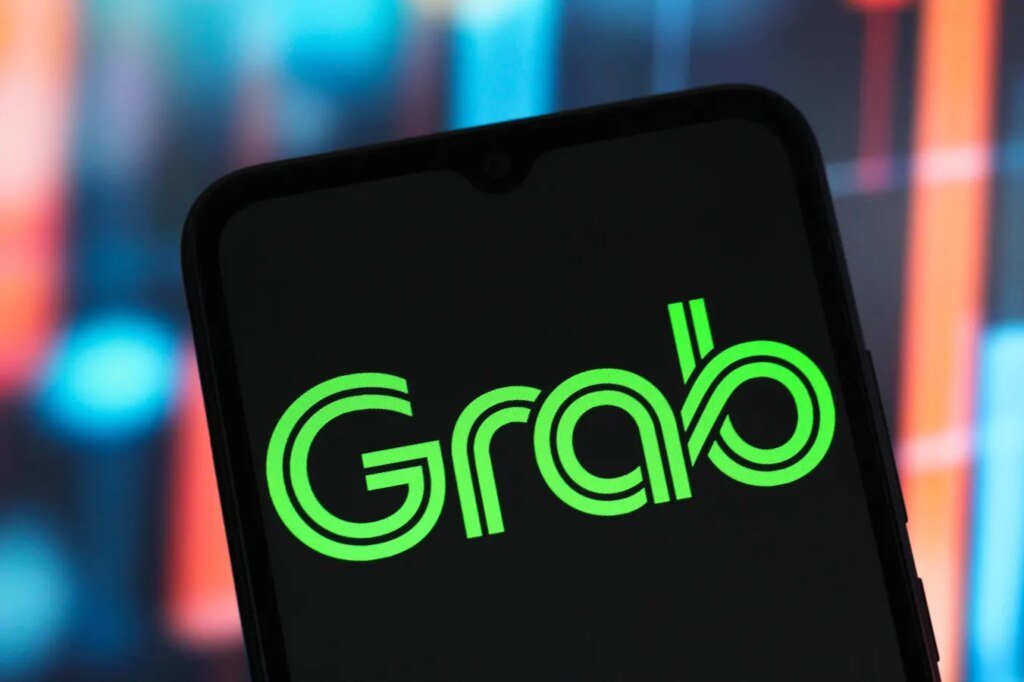GRAB stock (NASDAQ: GRAB) stock has grown 24% year to date, fueled by growing optimism around its improving profitability, expanding fintech business, and the broader rebound in Southeast Asia’s ride-hailing and delivery demand. Investor sentiment has also been supported by the company’s progress in cutting costs and accelerating revenue growth through higher user engagement and cross-platform services.
However, we believe it may be an opportune time to trim exposure to GRAB stock. While the company’s Moderate operational execution and improving financial discipline are commendable, the Very High valuation and competitive risks make the stock Unattractive at current levels.
CANADA – 2025/06/11: In this photo illustration, the Grab Holdings Limited logo is seen displayed on a smartphone screen. (Photo Illustration by Thomas Fuller/SOPA Images/LightRocket via Getty Images)
SOPA Images/LightRocket via Getty Images
Key concerns linger. Competition remains fierce across both the mobility and delivery segments, with regional rivals such as Gojek and Foodpanda maintaining aggressive pricing and promotional strategies. Meanwhile, growth in Grab’s fintech arm faces regulatory and credit-quality headwinds, potentially tempering margin expansion. Although the path to sustained profitability appears clearer, the stock’s sharp run-up already prices in much of the near-term optimism.
Below is our evaluation:
GRAB Stock Evaluation
Trefis
GRAB stock has the potential to fluctuate. A well-rounded allocation, less so. Empirical Asset Management combines strategy and discipline to mitigate market volatility.
Let’s delve into the details of each of the assessed factors, but first, for a brief background: With $24 Bill in market cap, Grab Holdings offers transportation, delivery, mobile payment, and financial services throughout Southeast Asia through an integrated fintech and mobility platform.
[1] Valuation Appears Very High
This table illustrates how GRAB’s valuation compares to the wider market. For additional information see: GRAB Valuation Ratios
[2] Growth Is Very Strong
- Grab has experienced an average top-line growth rate of 71.1% over the last three years
- Its revenues have increased by 17% from $2.5 Bil to $2.9 Bil in the past year
- Additionally, its quarterly revenues rose by 18.4% to $773 Mil in the most recent quarter from $653 Mil a year prior.
This table illustrates how GRAB’s growth compares to the larger market.
[3] Profitability Seems Weak
- In the last 12 months, GRAB’s operating income was $13 Mil, which translates to an operating margin of 0.4%
- With a cash flow margin of 32.1%, it produced almost $936 Mil in operating cash flow during this time
- For the same period, GRAB reported nearly $23 Mil in net income, indicating a net margin of around 0.8%
This table shows how GRAB’s profitability compares to the wider market.
[4] Financial Stability Feels Very Strong
- At the close of the most recent quarter, GRAB’s Debt stood at $385 Mil, while its current Market Cap is $24 Bil. This results in a Debt-to-Equity Ratio of 1.6%
- GRAB’s Cash (including cash equivalents) constitutes $5.9 Bil of $9.6 Bil in total Assets, resulting in a Cash-to-Assets Ratio of 61.0%
[5] Downturn Resilience Is Moderate
GRAB experienced an effect slightly better than the S&P 500 index during various economic downturns. This assessment is based on both (a) the extent of the stock’s decline and, (b) the rapidity of its recovery.
2022 Inflation Shock
- GRAB stock decreased by 86.5% from a high of $17.06 on November 11, 2021, to $2.31 on October 24, 2022, compared to a peak-to-trough drop of 25.4% for the S&P 500.
- The stock has not yet returned to its pre-Crisis high
- The highest the stock has achieved since then is $6.45 on September 22, 2025, and it is currently trading at $5.94
2020 Covid Pandemic
- GRAB stock dropped 5.6% from a peak of $13.62 on December 22, 2020, to $12.86 on December 31, 2020, as opposed to a peak-to-trough decline of 33.9% for the S&P 500.
- Nonetheless, the stock completely recovered to its pre-Crisis peak by January 7, 2021
However, the risk is not confined to major market declines. Stocks can decline even when markets are favorable—consider situations like earnings reports, business updates, or outlook adjustments. See GRAB Dip Buyer Analyses for insights on how the stock has rebounded from significant declines previously.
The Trefis High Quality (HQ) Portfolio, comprising 30 stocks, has consistently outperformed its benchmark that includes all three—S&P 500, Russell, and S&P midcap. What accounts for this? Generally, HQ Portfolio stocks produced improved returns with less risk compared to the benchmark index; thereby offering a smoother performance, as evidenced by HQ Portfolio performance metrics.


